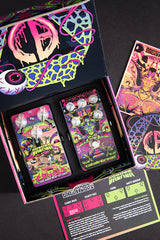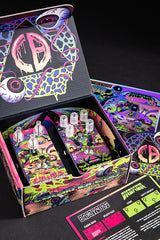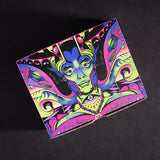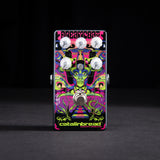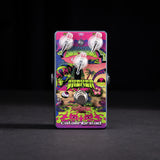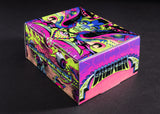Catalinbread Dreamcoat Skewer Special Edition Box
$299
Catalinbread Dreamcoat Skewer Special Edition Box
This box set is not meant to nail Blackmore’s tone, but rather be a toolkit to help you make your own sonic footprint. The DREAMCOAT has the exact specs of the Aiwa TP-1011 reel-to-reel preamp that Blackmore used; with some extra features. It can be an unruly, velcro-y, and sputtery beast, but one that can be tamed at low levels for a more classic rock approach. Think of it like a console being blown out but completely under your control. The SKEWER operates similarly to our Naga Viper pedal, but rather than being based on the Dallas Rangemaster, it is based on the Hornby-Skewes Treble Booster—another iconic piece of Blackmore's gear. All the pedal geekdom about what is in these pedals can be found below.
About the Dreamcoat:
What began as an exploration of Ritchie Blackmore’s tone evolved into a multidimensional gain machine capable of anything between unruly sputtery fuzz and classic rock chime. This is not meant to make you sound like Blackmore, it is meant to inspire you from using the tools that he did, that would otherwise be inaccessible in pedal form. The heart and soul of the Dreamcoat is a near-exact recreation of the preamp circuit from the Aiwa TP-1011 reel-to-reel deck that Blackmore used on many of his recordings. All of the functionality of that unit is present, from sparkling cleans to powerful crunch and glassy leads, but the “Sat” control gives you an extra layer of grunt, allowing the Dreamcoat to range between near-dry tonal indifference to complete “melting-amp” Neil Young-esque tweed sounds. Blackmore’s sound wasn’t just a tape deck, though. His guitar tech, Dawk Stillwell, installed a passive inductor-based frequency “booster” into Ritchie’s Strat that cut both sides of the spectrum around the resonant frequency of his guitar, giving the appearance of frequency boost. To that end, we’ve added a frequency booster circuit that doesn’t cut anything, giving you a richer tone with a little oomph where it counts. To top it all off, we’ve included a clean blend circuit that begins after the frequency boost and ends after the tape preamp, so you can EQ the sum of your clean tone and dirt, all while preserving your pick attack and presence. The whole shebang runs at 20V, just a hair higher than the original Aiwa, expanding its capabilities and delivering tons of headroom.
Controls:
FREQ: This controls the amount of boost at a specified frequency band, from 2.4KHz to 5KHz, which you set with the internal trimmer. When the knob is fully counter-clockwise, it’s out of the circuit. When you turn it up all the way, you’ll get a full 10dB boost at the selected frequency. Warning: a little goes a long way with this control, as ~4KHz is where pink noise and other unpleasantries live.
BLEND: This control blends the signal coming out of the Freq control with the Aiwa deck circuit. Nudge it south-of-max to gain back some of your pick attack, and turn it all the way down to hear just the EQ’d dry signal. When all the way down, make sure you turn your master up to compensate and
vice-versa. When your Sat and Mic Vol are cranked and your Blend is just above 0, the resulting dynamic between your dry signal and those more extreme splatty Dreamcoat settings create a truly unique tone.
SAT: Controls the amount of feedback present in the first stage of the Aiwa unit. You can think of it as a “gain range” control. This control was not included on the original unit and was set to a fixed value. The default setting on the original is a hair past noon, everything else is extra. If you find that you are getting too much sputter, turn this control down.
MIC VOL: This is the original “distortion” control of the Aiwa deck and controls the total “distortion” of the circuit.
MASTER: You know what this does. You will never want for volume with the Dreamcoat, it can get punishingly loud. After all, the Aiwa was meant to drive speakers! As you adjust the Blend control, you may need to turn this up.
FREQUENCY TRIMMER: Blackmore had his passive “boost” tailored to the resonant frequency of his Strat, accentuating pinch harmonics. While you may not play the man’s actual guitar (seriously, props if you do), you may want to spend some time dialing this in. This is definitely a “set-it/forget-it” type of control, as you dial it to suit your guitar best. Of course, you can experiment with different frequencies and let the FREQ knob do the talking.
Power: The Dreamcoat requires a 9V power supply center-negative and draws 44mA. Any more current than that is A-OK, but you can’t exceed 9V without letting the smoke out. Bad things will happen, including but not limited to shouting expletives and more importantly, voiding your warranty.
About the Skewer:
One of Blackmore’s most recognizable pieces of gear is his old Hornby-Skewes Treble Booster, a version of the classic effect used by too many artists to list. While almost all of them used a Rangemaster, the Hornby-Skewes version came stock with a silicon transistor for a more biting sound that cut through even the densest of mixes. The SKEWER stays true to that circuit, giving the old JHS unit the same treatment as our Naga Viper. This lets you dial in the desired frequency range from rich and full to treble-heavy, as well as control the amount of boost. You can also vary the amount of transistor gain for some extra juice. Of course, because it’s Blackmore we’re talking about here, he had his original Treble Booster modded to play nicer with the rest of his gear. We’ve taken the liberty of giving you that mod as well, which is fully adjustable via the trimpot inside. Further enhancements include a noise reduction filter and anti-pop switch circuitry. This one bites just a little harder than our Naga Viper, and sounds fantastic with the DREAMCOAT.
Controls:
SKEW: Adjusts the frequency response of the boost, which also slightly affects the gain. When dialed fully counter-clockwise, you get full range and max gain. When dialed fully clockwise, you get the stock setting of the original H-S Treble Booster.
BOOST: Adjusts the amount of boost. Stock H-S setting is about 2/3 up.
EXTRA: Adjusts level of gain extracted from the transistor. Crank this setting to get rowdy.
INTERNAL TRIMMER: This is a master volume control. It's included because rumor has it that Blackmore had his TB modded for master volume to make it sound better with his amp. Default is all the way up. Blackmore allegedly liked it at about 80%.
Power: The Skewer requires a 9V power supply center-negative and draws 44mA. Any more current than that is A-OK, but you can’t exceed 9V without letting the smoke out. Bad things will happen, including but not limited to shouting expletives and more importantly, voiding your warranty.
This box set is not meant to nail Blackmore’s tone, but rather be a toolkit to help you make your own sonic footprint. The DREAMCOAT has the exact specs of the Aiwa TP-1011 reel-to-reel preamp that Blackmore used; with some extra features. It can be an unruly, velcro-y, and sputtery beast, but one that can be tamed at low levels for a more classic rock approach. Think of it like a console being blown out but completely under your control. The SKEWER operates similarly to our Naga Viper pedal, but rather than being based on the Dallas Rangemaster, it is based on the Hornby-Skewes Treble Booster—another iconic piece of Blackmore's gear. All the pedal geekdom about what is in these pedals can be found below.
About the Dreamcoat:
What began as an exploration of Ritchie Blackmore’s tone evolved into a multidimensional gain machine capable of anything between unruly sputtery fuzz and classic rock chime. This is not meant to make you sound like Blackmore, it is meant to inspire you from using the tools that he did, that would otherwise be inaccessible in pedal form. The heart and soul of the Dreamcoat is a near-exact recreation of the preamp circuit from the Aiwa TP-1011 reel-to-reel deck that Blackmore used on many of his recordings. All of the functionality of that unit is present, from sparkling cleans to powerful crunch and glassy leads, but the “Sat” control gives you an extra layer of grunt, allowing the Dreamcoat to range between near-dry tonal indifference to complete “melting-amp” Neil Young-esque tweed sounds. Blackmore’s sound wasn’t just a tape deck, though. His guitar tech, Dawk Stillwell, installed a passive inductor-based frequency “booster” into Ritchie’s Strat that cut both sides of the spectrum around the resonant frequency of his guitar, giving the appearance of frequency boost. To that end, we’ve added a frequency booster circuit that doesn’t cut anything, giving you a richer tone with a little oomph where it counts. To top it all off, we’ve included a clean blend circuit that begins after the frequency boost and ends after the tape preamp, so you can EQ the sum of your clean tone and dirt, all while preserving your pick attack and presence. The whole shebang runs at 20V, just a hair higher than the original Aiwa, expanding its capabilities and delivering tons of headroom.
Controls:
FREQ: This controls the amount of boost at a specified frequency band, from 2.4KHz to 5KHz, which you set with the internal trimmer. When the knob is fully counter-clockwise, it’s out of the circuit. When you turn it up all the way, you’ll get a full 10dB boost at the selected frequency. Warning: a little goes a long way with this control, as ~4KHz is where pink noise and other unpleasantries live.
BLEND: This control blends the signal coming out of the Freq control with the Aiwa deck circuit. Nudge it south-of-max to gain back some of your pick attack, and turn it all the way down to hear just the EQ’d dry signal. When all the way down, make sure you turn your master up to compensate and
vice-versa. When your Sat and Mic Vol are cranked and your Blend is just above 0, the resulting dynamic between your dry signal and those more extreme splatty Dreamcoat settings create a truly unique tone.
SAT: Controls the amount of feedback present in the first stage of the Aiwa unit. You can think of it as a “gain range” control. This control was not included on the original unit and was set to a fixed value. The default setting on the original is a hair past noon, everything else is extra. If you find that you are getting too much sputter, turn this control down.
MIC VOL: This is the original “distortion” control of the Aiwa deck and controls the total “distortion” of the circuit.
MASTER: You know what this does. You will never want for volume with the Dreamcoat, it can get punishingly loud. After all, the Aiwa was meant to drive speakers! As you adjust the Blend control, you may need to turn this up.
FREQUENCY TRIMMER: Blackmore had his passive “boost” tailored to the resonant frequency of his Strat, accentuating pinch harmonics. While you may not play the man’s actual guitar (seriously, props if you do), you may want to spend some time dialing this in. This is definitely a “set-it/forget-it” type of control, as you dial it to suit your guitar best. Of course, you can experiment with different frequencies and let the FREQ knob do the talking.
Power: The Dreamcoat requires a 9V power supply center-negative and draws 44mA. Any more current than that is A-OK, but you can’t exceed 9V without letting the smoke out. Bad things will happen, including but not limited to shouting expletives and more importantly, voiding your warranty.
About the Skewer:
One of Blackmore’s most recognizable pieces of gear is his old Hornby-Skewes Treble Booster, a version of the classic effect used by too many artists to list. While almost all of them used a Rangemaster, the Hornby-Skewes version came stock with a silicon transistor for a more biting sound that cut through even the densest of mixes. The SKEWER stays true to that circuit, giving the old JHS unit the same treatment as our Naga Viper. This lets you dial in the desired frequency range from rich and full to treble-heavy, as well as control the amount of boost. You can also vary the amount of transistor gain for some extra juice. Of course, because it’s Blackmore we’re talking about here, he had his original Treble Booster modded to play nicer with the rest of his gear. We’ve taken the liberty of giving you that mod as well, which is fully adjustable via the trimpot inside. Further enhancements include a noise reduction filter and anti-pop switch circuitry. This one bites just a little harder than our Naga Viper, and sounds fantastic with the DREAMCOAT.
Controls:
SKEW: Adjusts the frequency response of the boost, which also slightly affects the gain. When dialed fully counter-clockwise, you get full range and max gain. When dialed fully clockwise, you get the stock setting of the original H-S Treble Booster.
BOOST: Adjusts the amount of boost. Stock H-S setting is about 2/3 up.
EXTRA: Adjusts level of gain extracted from the transistor. Crank this setting to get rowdy.
INTERNAL TRIMMER: This is a master volume control. It's included because rumor has it that Blackmore had his TB modded for master volume to make it sound better with his amp. Default is all the way up. Blackmore allegedly liked it at about 80%.
Power: The Skewer requires a 9V power supply center-negative and draws 44mA. Any more current than that is A-OK, but you can’t exceed 9V without letting the smoke out. Bad things will happen, including but not limited to shouting expletives and more importantly, voiding your warranty.
Our customers are now welcome to visit the Brian's Guitars showroom without an appointment! Thank you for all of the patience and understanding over the past year.
Thank you all for your understanding and cooperation!

